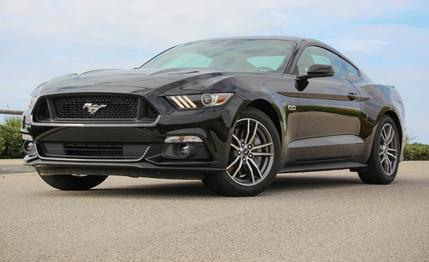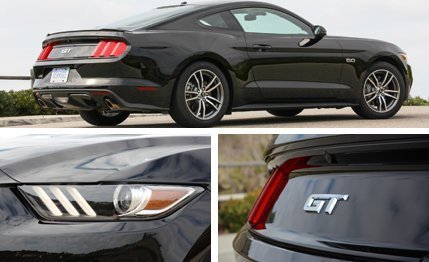 Instrumented Test
Instrumented Test
While we have nothing but praise and admiration for Ford’s decision to spread stick shifts around the new Mustang lineup, the fact is that many of you will buy automatics just as your forebears did in the 1960s. Back then, slushboxes were the gooey, horsepower-gobbling Neanderthal ancestors to today’s computer-linked, electrohydraulic torque-thrusters. The basics of clutched planetary gearsets remain unchanged, but today’s performance is entirely different. Congratulations on surviving to the Age of Automatics We Can Live With.
The new Mustang GT is a solid citizen of this era, partly because the six-speed automatic transmission is so good as to be nearly transparent, and partly because Ford has built a car around the lazy-left-foot gearbox that isn’t trying to be excessively sporty. The GT is powerful and fast, to be sure, but a bit more mellow and refined in this, the new Mustang’s initial V-8 iteration. We already know of three more hot Mustangs coming, the Shelby GT350, GT350R, and, in all likelihood, a fresh GT500; these will grind the Mustang to a harder edge, so this big-hearted cruiser is for people who don’t want their finger in the socket for every mile.
The 10Best-winning Mustang GT starts at $32,925 with a stick, and for the auto you must check an $1195 option box that also brings steering-wheel paddles and remote start. Do that and you’re locked out of the GT Performance Pack, a $2495 slew of goodies that includes Brembo brakes, 19-inch rims wrapped in summer tires, and a 3.73:1 Torsen limited-slip differential. You can option 19s and a 3.55:1 rear end separately but not the full shot. So Ford is not positioning the slusher for street racers who just don’t want to shift. It’s for people wanting V-8 power but more luxury than go-fast gear. The automatic’s option price remains consistent up through the GT’s Premium and 50th Anniversary trim levels. (The limited-edition latter model was the only way to get the automatic with the Performance Pack.)

Automatic gearboxes have “long been a millstone around our neck,” one former Ford engineer told us once, but the ghosts of fragile AODs and AXODs have largely been exorcised, especially as Ford has moved to the modern rear-drive 6R unit based on the ubiquitous and sturdy ZF 6HP26. For the new Mustang, Ford says it redesigned and strengthened the case for enhanced driveline stiffness and reduced shift shock.
Whatever the company is doing, it’s working. Left alone in D, the transmission snaps new ratios into place with a lubricated, seamless efficiency. Take control with the paddles and the engine pleasingly matches revs on the downshift. Neither the roar nor the shove of the four-cam, 435-hp V-8 seems dimmed by its marriage to a torque converter.
Even on the automatic’s loose set of Pirelli P Zero Nero all-season tires, the GT is able to get out of the hole as quick as the stick running the optional summer rubber. We saw 60 mph pass in 4.5 seconds and the quarter-mile in 13.0 seconds at 113 mph, identical to the manual’s times. Still, the low-grip rubber prevented recording anything better than a 0.83-g skidpad run, far less than the 0.95 posted by the last stick-shift car we tested on the summer Pirelli P Zeros.
In comparison to, say, a Camaro SS 1LE, the basic Mustang GT is a floater. Ford has chosen a relatively mushy suspension tune that makes the GT a serene choice for long highway trips but a slightly squishier steed on the twisty sections. At times, such as when crossing onto the varied surfaces of bridge overpasses at 70 mph, the nose develops a distinctly vintage circular bob as the circa-3800-pound car does a slight shimmy and porpoise at the same time. Undulations can really work over the base GT’s springs, while the all-season tires can ruin a good switchback with some squealing understeer. But the bumps are likewise better absorbed and the occupants remain largely isolated from the worst. As we said, harder Mustangs are coming, as is a slew of aftermarket filling-looseners for those wanting to starch up the GT’s suspension. Or you could get a manual and order the Performance kit.

Inside, the Mustang is the new kid on the pony-car block and it shows, with the latest and greatest materials and electronic frippery, such as blind-spot warning, parking sensors, and a cross-traffic alert that prevents you from backing out of the driveway into an oncoming petroleum tanker. Drop the extra $4000 for a GT Premium and you’re swaddled in soft-touch leather, aluminum trim, and chrome accents. Click the unlock button on the fob and tiny lamps hidden in the side-view mirrors project the galloping Mustang logo on the ground next to the car, a great party trick.
The screen in the Mustang’s cluster can be configured to digitally render all kinds of fascinating gauges you didn’t know you needed, such as twitching dial indicators for the air/fuel ratio, intake vacuum, and the inlet-air temperature. It’s with this screen and accompanying buttons that you engage the Track mode for the stability control and the all-important line-lock function, which at a standstill allows you to electronically lock just the front brakes and barbecue the rear tires for up to 15 seconds. A toggle in the center stack lets you dial up the steering effort from Comfort to Normal to Sport.
None of the foregoing is to say that the automatic-transmission Mustang GT is a bad handler; it’s simply set on the soft side on its base suspension, and it is a perfect pleasure to drive at seven-tenths given its direct steering and reassuring brakes. Ford’s engineers obviously left overhead clearance in the suspension for the Performance pack and future models. That frees up the GT automatic to be what its name implies: a comfortable, everyday-usable gran turismo.